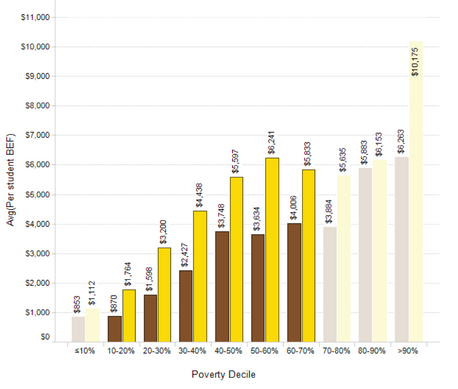The Data Are Damning: How Race Influences School Funding
Research shows that in Pennsylvania’s public schools skin color, not economics, determines how much money districts get.
PHILADELPHIA—In America, schools with a lot of minority students are chronically underfunded. Is that the case because these students are poor, and poor communities have fewer resources for funding their schools? Or, is it because of the color of these students’ skin?
Unsettlingly, recent research from data scientist David Mosenkis finds that poverty alone does not explain the underfunding. Mosenkis delved into funding data for 500 school districts in the state of Pennsylvania. Because richer school districts are able to drum up more cash through taxes, they should receive less state funding, and poorer districts should receive more. He looked at how much money they received and sorted those findings based on race and income.
Using a broad scope, Mosenkis found what one might expect: On the surface poor districts do receive more state funding than rich schools. But when he delved deeper into the data, sorting by race, what he found was disturbing.
District Funding, by Racial Composition and Poverty Level
“If you color code the districts based on their racial composition you see this very stark breakdown. At any given poverty level, districts that have a higher proportion of white students get substantially higher funding than districts that have more minority students.” That means that no matter how rich or poor the district in question, funding gaps existed solely based on the racial composition of the school. Just the increased presence of minority students actually deflated a district’s funding level. “The ones that have a few more students of color get lower funding than the ones that are 100 percent or 95 percent white,” Mosenkis said.
Issues with scarce budgets and troubled urban schools aren’t new, and they exist all over the country. In an article published in The Atlantic in 1954, Henry I. Willett attempted to answer the question of whether or not public schools cost too much by saying, “The amount spent for educational purposes as compared with amounts spent for many other items and services, including luxuries, would indicate that the importance of education in our democracy is not yet realized: and the hour is growing late.”
In Pennsylvania, the crisis is particularly acute. The state’s former governor stripped the education budget significantly. In the years since, schools have shuttered, teachers have been fired, and the schools that remain are existing on bare-bones budgets. Earlier this year, two children died after getting sick at district schools where no nurses were on duty due to budget reductions. Pennsylvania is also one of the only states in the country that hasn’t had a specific formula in place for distributing government aid to its districts. That’s left lots of room for partisan politics and funding bias.
Funding Per Student, by Race and Poverty Level
This year, Pennsylvania Governor Tom Wolf—who took office in January—proposed increasing education funding in the state. And after studying the disbursement of funds, the Basic Education Funding Commission has voted toadopt a new formula that would theoretically address much of the bias when it comes to how state funds are doled out. That’s great, but the new formula hasn’t actually been enacted and the state has yet to actually pass a budget.
But even when both of those tasks are complete, it won’t eradicate the problem of racial bias in the state’s school funding appropriation. Mosenkis says that the The Troubling Link Between School Funding and Race - The Atlantic:


